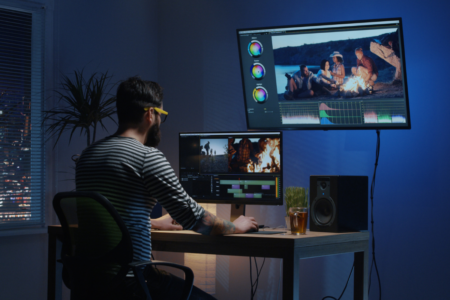Sports have always stood at the intersection of human abilities and technological innovation.
Over the years, advancements in technology have played an instrumental role in reshaping the landscape of sports, transcending the limits of what athletes can achieve.
Wearable technology, once confined to science fiction, has become an integral part of an athlete’s toolkit.
Devices with GPS trackers, heart rate monitors, and accelerometers offer real-time insights into an athlete’s performance.
Whether it’s a sprinter monitoring their speed or a basketball player tracking their heart rate during a high-intensity game, these wearables provide invaluable data for personalized training regimens and injury prevention.
The integration of artificial intelligence algorithms further refines this data, offering tailored recommendations and insights, leveling the playing field for athletes across all levels of competition.
Wearable Technology And Performance Tracking
Wearable technology has emerged as a cornerstone in modern sports training. Athletes now have access to various devices that monitor crucial metrics in real-time.

GPS trackers, heart rate monitors, and accelerometers provide coaches and athletes unprecedented insight into performance.
For example, a soccer player can track their distance covered, sprint speed, and heart rate during a match.
This data-driven approach enables personalized training regimens and helps prevent overexertion and injuries.
One of the most notable developments is integrating artificial intelligence (AI) in wearables.
AI algorithms analyze data to offer actionable insights, such as fatigue levels, optimal training zones, and recovery recommendations.
These devices are now indispensable tools for professional and amateur athletes, leveling the playing field and helping individuals reach their full potential.
The information gathered from wearables is not only beneficial for individual performance but also aids coaches in making informed decisions about game strategies and player rotations.
Wearables have proven to be invaluable in post-game analysis. Athletes and coaches can review data to identify areas for improvement and track progress over time.
This iterative feedback loop is a powerful tool in pursuing excellence, allowing for constant refinement and performance enhancement.
Virtual Reality (VR) and Augmented Reality (AR) Training
Virtual Reality and Augmented Reality have shifted the paradigm to sports training. Athletes can now immerse themselves in realistic virtual environments that mimic game scenarios.
This technology is particularly valuable for quarterbacks in American football, providing them with a platform to practice decision-making under pressure.
VR and AR enable athletes to visualize plays, assess opponents’ movements, and refine their tactical awareness.
Beyond training, VR and AR have also enriched the fan experience. Spectators can enjoy an immersive view of the game from the comfort of their homes or even experience the thrill of being on the field through VR headsets.
Other than that, VR is not limited to viewers and athletes only, bettors can make use of VR to place bets realistically from their homes using sports betting apps recommended by Rotowire.com, all while feeling like they are physically present at the event.
VR and AR have paved the way for groundbreaking rehabilitation techniques. Injured athletes can use these technologies to engage in virtual therapy sessions, allowing them to perform movements in a controlled, immersive environment. This accelerates the recovery process and ensures a safe return to play.
Biomechanical Analysis and Motion Capture
Biomechanical analysis has revolutionized how athletes refine their techniques. High-speed cameras and motion capture systems meticulously record every aspect of an athlete’s movement, providing invaluable data for performance enhancement.
This technology is invaluable in sports like golf, where even minor adjustments in swing mechanics can lead to significant improvements.
Furthermore, biomechanical analysis plays a crucial role in injury prevention and rehabilitation.
By studying athletes ‘ movements, experts can identify potential stress points or imbalances that may lead to injuries.
This proactive approach allows for targeted interventions, such as specific exercises or modifications in technique, to mitigate risks and keep athletes in optimal condition.
Biomechanical analysis has led to breakthroughs in equipment design. Manufacturers can use this data to create gear that complements an athlete’s natural movements, enhancing performance and reducing the risk of injury.
This synergy between technology and equipment design drives innovation across various sports disciplines.

Smart Equipment and Gear
Traditional sports equipment has undergone a technological renaissance. Smart gear, embedded with sensors and microchips, offers real-time feedback to athletes.
For instance, smart basketballs can track. shooting accuracy and provide instant analysis of shooting form.
Smart tennis rackets can measure ball speed, spin, and impact location. This data empowers athletes to fine-tune their skills with precision.
Moreover, smart equipment contributes to the development of a quantified athlete. These sensors provide data that goes beyond basic performance metrics.
They can track an athlete’s biometrics, such as heart rate variability, muscle activation, and even hydration levels.
By gathering this comprehensive data, athletes can optimize their training regimens and make informed decisions about their overall health and well-being.
Furthermore, smart protective gear enhances athlete safety. Helmets with impact sensors alert medical staff when a player sustains a potentially dangerous hit.
This timely information allows for immediate evaluation and treatment, minimizing the risk of serious injuries.
Integrating technology into protective gear has drastically improved player safety in contact sports, giving athletes and their families greater peace of mind.
Sports Analytics and Data-driven Insights
Big data and analytics have transformed how sports are strategized and played. Teams can access a wealth of information, from player statistics to game performance metrics.
Advanced algorithms crunch this data to uncover patterns, trends, and insights that were previously unattainable.
Coaches can now make data-driven decisions about player selection, game tactics, and training regimens. This approach maximizes the team’s strengths and exploits opponents’ weaknesses.
Moreover, sports analytics has given rise to a new breed of professionals – sports analysts – who dissect data to provide invaluable insights to teams and fans.
Additionally, sports analytics has improved the fan experience by giving viewers a deeper understanding of the game.
Real-time statistics, predictive analysis, and interactive graphics have become integral to sports broadcasts.
This engages the audience and educates them about the difficulties of the sport, fostering a more informed and enthusiastic fan base.
Fan Engagement and Immersive Experiences
Technology has not only impacted athletes but has also transformed the way fans interact with sports.

Social media platforms, virtual reality experiences, and augmented reality apps are just a few examples of how fans can now immerse themselves in the world of sports.
Additionally, interactive features such as live polling, virtual cheering, and real-time commentary on streaming platforms have elevated the fan experience to a new level.
5G technology has revolutionized how fans consume sports content. With faster and more reliable internet connections, fans can stream games in high definition on their mobile devices, ensuring they never miss a moment of the action. This has expanded the global reach of sports, connecting fans worldwide.
Advancements in sports broadcasting technology have enabled fans to have a more comprehensive view of the game.
Multiple camera angles, instant replays, and in-depth analysis have become standard, providing a more immersive and engaging viewing experience.
Summary
The convergence of sports and technology has ushered in an era of unprecedented innovation and advancement.
These game-changing technologies enhance athletes’ performance and safety and revolutionize how fans engage with their favorite sports, from wearable tech to virtual reality training.
In this rapidly evolving landscape, athletes, coaches, and sports organizations must embrace these technologies and leverage them to their full potential.
By doing so, they will gain a competitive edge and contribute to the continued growth and evolution of the sports industry.
The future promises even greater technology integration, opening up new frontiers in performance enhancement, fan engagement, and athlete safety.
As we look ahead, one can only imagine the extraordinary possibilities for the world of sports.








